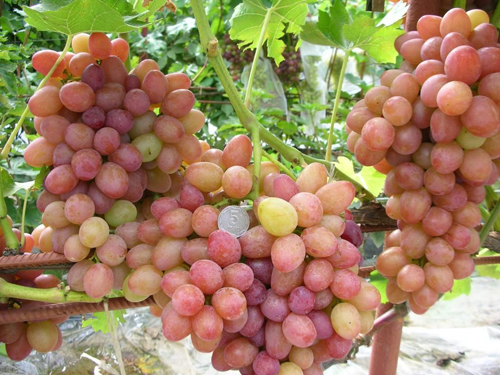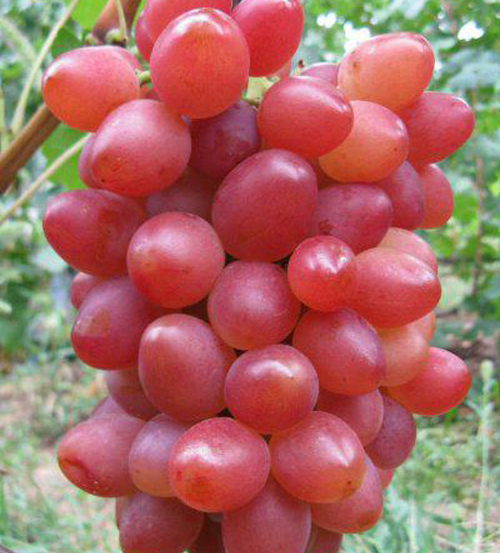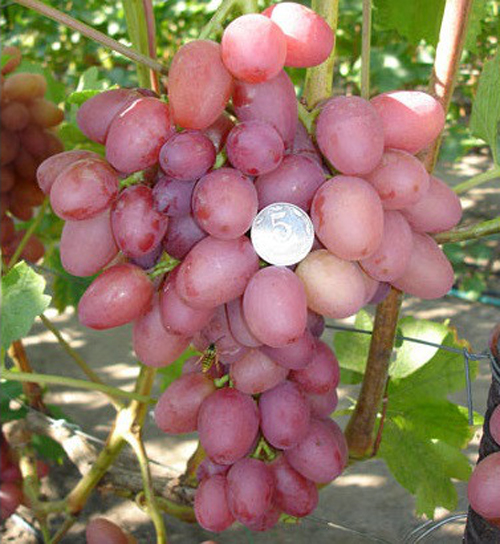Sofia grape variety
The hybrid table form of Sofia grapes is one of the magnificent creations of the Ukrainian national breeder Vitaly Zagorulko from Zaporozhye. Moreover, this hybrid is known not only in itself, but also as the mother form of a number of other brainchilds of the researcher, who have won numerous awards and prizes at all kinds of industry shows and competitions.
Such a fertility of the variety is associated with a specific functionally female type of flowering, which is a disadvantage in productive viticulture, but greatly facilitates the crossing procedure when developing new varieties. After all, let's not forget that most amateur breeders are not professional scientists with biological or agricultural education, and therefore preparing a bisexual flower for controlled cross-pollination is a rather difficult task for them. Without varieties of grapes with a female type of flowers, it is unlikely that these enthusiasts have succeeded in breeding tens and hundreds of the newest hybrids with an amazing variety of sizes, shapes, colors and tastes of fruits in a very short period of time in a historical scale.

Vitaly Vladimirovich Zagorulko is no exception. As an engineer by training, he began to engage in viticulture as an amateur in the 80s of the last century, and crop breeding - 10-15 years later, only after he learned the basics of its cultivation. Gradually, the works of the master began to gain popularity among summer residents, then heads of farms drew attention to them, and some were even honored to be included in the state registers of varieties approved for industrial use in Ukraine and Russia.
Sofia did not have such success, but many of her descendants are quite worthy of participation in the state variety testing. And she herself enjoys great success in amateur viticulture, having won the sincere sympathy of a significant number of fans there. It happened as a result of crossing a famous Ukrainian variety Arcadia and equally popular grapes Radiant kishmish from Moldova. From her ancestors such excellent qualities as early maturity, large-fruited, wonderful presentation, lack of seeds in the part of berries, pleasant taste with a bright nutmeg aroma and aftertaste were passed on to her. At the same time, it is not without its drawbacks. In addition to the notorious FZhTs, they include very modest indicators of frost resistance, some predisposition to cracking of berries in unfavorable years and a rather knocked down bunch, due to which the grapes are prone to decay. Assessing these properties in aggregate, the advantages of Sofia naturally outweigh its disadvantages, which testifies to the great prospects of the form and the validity of the wide interest in it on the part of winegrowers.
Agrobiological characteristics
The vigor of the bushes is assessed as high. The hybrid forms powerful, thick, erect shoots that can bear a very high yield. The crown of the shoot and young leaves are dark green, shiny, without pubescence. Fully developed grape leaves are very large, rounded, slightly wavy or funnel-shaped, five-lobed with a slight degree of dissection. The front side of the leaf is smooth, emerald, there is no pubescence on the back. The upper side cutouts are shallow, V-shaped or slotted. The lower notches are barely outlined or completely absent. The petiole notch is often open lyre-shaped with a rounded bottom, but it can also be closed with an ovoid lumen. Petioles are of medium and above medium length, green, sometimes with a slight pink tint. The denticles along the perimeter of the leaf blade are of medium size, different in shape, partly triangular with smooth edges and sharp tops, partly dome-shaped.The flowers of the variety are female, for fertilization and harvesting, the presence of a number of bisexual pollinator varieties that bloom at the same time is necessary. When this condition is met, Sofia does not have problems with the formation of the ovary, the clusters grow large, and the berries do not peel in them. The shedding of flowers behind it was also not noticed. The maturation of the one-year growth is going well. The color of the vine turns bright brown. The autumn color of the foliage is greenish-yellow.

The bunches of grapes are very large, their weight can reach three kilograms, and on average it ranges from 800 to 1500 grams. The shape of the brushes is broadly conical, the density is usually high. The comb is long and strong, yet rather graceful, pale green with pinkish tones that appear in good light. The berries are very well aligned in relation to each other, oval or ovoid, similar in shape to the parent Arcadia variety, and in color to the paternal radiant Kishmish. The length of a medium-sized grape is 30-34 mm, diameter - 20-21 mm, weight - 13-15 grams. Due to the high density of the bunches, deformation of the berries and their damage can occur, accompanied by the appearance of a putrefactive focus, which can quickly spread throughout the brush. The flesh of the berries is very juicy, tender-fleshy, literally melting in the mouth. The taste is pleasant, harmonious, with tones of nutmeg in the aftertaste and aroma. Grape juice is colorless, the sugar content in it is high - up to 20-22 g / 100 ml. There is no information on the titratable acidity, however, according to the taste sensations, winegrowers estimate it as low. After full ripening, the peel becomes very fragile, and when chewed, practically weightless. Its surface is from golden to deep pink, a protective wax coating is light, of medium density. There are few seeds in the berries, only in the largest grapes can be found up to two pieces, but often they are absent altogether. Taste qualities are highly rated during tasting.
The direction of use of the crop is most often dessert. Gastronomically remarkable grapes evoke only admiration among the majority of people who have tasted it. And if we add to this the outstanding indicators of external attractiveness and presentation, then we can undoubtedly attribute Sofia to the so-called. “Market” varieties that are popular with farmers who cultivate the “sun berry” for sale. At the same time, significant disadvantages for this direction of cultivation of the variety are the low transportability of the harvested crop and its mediocre suitability for storage. This is due to the thin skin and delicate texture of the berries, as a result of which such flaws can be considered a natural payback for the excellent tasting characteristics. For some improvement of these technological parameters, it is recommended to carefully harvest ripe bunches, a clear marker of which will be the absence of damage to the pruin layer on the surface of the berries. For winegrowers cultivating a hybrid for their own consumption, such problems are completely irrelevant, because they do not need to transport the crop over long distances, and the surplus is excellent for processing into juices, compotes, jams

Ripening period is early. From the moment the buds open in the spring, only 110-115 days pass until the harvest reaches removable ripeness. For a short growing season, very little heat is required. The sum of active temperatures is about 2250-2350 ° C, which makes Sofia suitable for cultivation in many areas of central Russia, which cannot be called viticultural. The ripening of the hybrid, stable over the years, is guaranteed to occur throughout the territory of Ukraine and the Central Black Earth Region of the Russian Federation.At the same time, amateurs cultivate the variety north of these places, however, in this case, it is necessary to take measures to increase the level of SAT, and in the coldest seasons be prepared for insufficient ripening of the bunches. By the way, this drawback is not evident, since even not fully ripe berries are quite edible, due to their rapid softening and active accumulation of sugars. The frost resistance of the variety is low (-21 ° C), and therefore it is sheltered for the winter almost everywhere.
Our heroine shows very good yield. The load, about 15 kilograms of grapes per bush, is painlessly "pulled" by adult plants. The form is characterized by high fruitfulness of shoots and a large number of inflorescences laid on them, which, in combination with the very large size of the bunches, determines the significant potential productivity of the variety. The latter often has to be limited by crop rationing. If this is not done, then the clusters on overloaded bushes become sharply smaller, sugar accumulation decreases, the growing season lengthens, and the plants run the risk of simply not preparing for winter, which is why they freeze out in severe frosts.
The bunches can continue to hang on the vine after they have reached the conditions characteristic of removable maturity. However, in this case, two points must be taken into account. Firstly, in the event of wet rainy weather or a sharp drop in soil moisture, a certain number of berries may crack, which will lead to the loss of the presentation of the crop. This is due to the thinness and fragility of the grape skin, which is not able to quickly respond to a sharp change in the volume of the fruit. The delicate skin also cannot prevent damage from wasps, which are the second major obstacle to long-term exposure of grapes to the bushes. Snagging and fragrant Sophia is very pleasant to annoying insects, which is why protection from them is required not only for ripe, but even ripening bunches.

Agrotechnical features
In the course of cultivating this variety, it is necessary to be aware that highly productive and high-quality forms are very rarely complex-stable and completely unassuming to care for. Our heroine, as you might have guessed, is not one of such rare varieties, and therefore, for the excellent gastronomic and aesthetic characteristics, you will have to pay an adequate price in the form of sufficient care for her. At the same time, one cannot talk about her effeminacy, but rather about her exactingness to take into account economically specific features.
The placement of the hybrid form on the ground should be carried out according to the principles established in viticulture. In particular, the best lands in terms of heat supply should be allocated for cultivation. Low valleys and gullies, slopes of cold exposures are completely unsuitable for this. Moreover, even in flat places, in the case of cultivating a variety in a moderately cool climate, protection from northern winds is required, with the help of which the sum of active temperatures increases and the microclimate as a whole improves. In amateur plantings, any buildings can serve as such protection, while grapes are placed on their southern side in the so-called. "Wall culture". With regard to the provision of moisture and mineral nutrition, Sofia behaves in a contradictory manner. On the one hand, as a high-yielding variety, it takes out significant volumes of nutrients and water from the soil for their dissolution and transpiration, but at the same time, a high nitrogen content in the soil and soil dampness during the ripening of bunches are not recommended for it. Moreover, wetlands and areas with a high level of groundwater are not suitable for it.The mechanical composition of the soil should ideally provide good water and air permeability.
Sofia reproduces in a variety of ways, the easiest of which, and accessible to almost any grower, is rooting and planting cuttings. However, a similar, as it is called, “own-rooted” culture is possible only in the absence of soil contamination by root phylloxera, which can lead to the death of unstable varieties in a matter of years. A more difficult, but at the same time, reliable way is to plant grapes with grafted seedlings, in which a special phylloxera-resistant variety acts as a stock. Often, grafted plants develop somewhat slower than their own rooted ones, but this disadvantage is more than compensated for by the confidence that the young bush will not disappear in 5-6 years. When planting, do not forget about the need to adhere to the recommendations for the area of plant nutrition. For vigorous varieties, which include our heroine, this figure should be at least 4.5-5 sq. meters, deviating upward or downward under the influence of a number of factors - soil fertility, provision of heat, moisture and nutrition.
Sofia, in the climatic conditions of the absolute majority of regions of our country, is a covering grape. Only on the subtropical coast of the Black Sea can you try to grow it on a trunk according to non-covering or semi-covering schemes. In other places of the wide geography of its distribution, cultivation takes place with warming of various intensities. In areas that are weak in terms of frost danger, the vine is simply removed from the trellis in the fall and buried in the ground. In regions that are more severe from the point of view of winter cold weather, insulation is carried out more thoroughly, using for this already such materials as straw, wood chips, peat, needle cotter, spruce branches
For plants that have entered fruiting, the main procedures are spring pruning and subsequent additional rationing of the load during green operations. Our heroine, as a result of the pruning, leaves 35-45 eyes on each bush. Before the flowering of grapes, the number of developed shoots is reduced to 22-25 by fragments of the weak and sterile, on which there is no point in wasting nutrients. In addition, inflorescences are thinned out on the remaining young vines, leaving only one for each of them. This procedure is very important because no matter how strong the shoot is, it will not be able to "stretch" to sufficient condition even two such large clusters, which usually grow on Sophia.
The mother variety Arkadia, planted next door, is best suited for pollination. During the period of peduncle protrusion, and then during flowering and in the "small pea" phase, it makes sense to try to carry out treatments with gibberellic acid at concentrations of 5:30:30 mg / l, respectively.This will not only allow the grapes to set better, but will also improve the appearance of the berries due to some elongation, and will also lead to an increase in the number of seedless grapes. In the process of growing brushes, it is recommended to thin out the number of berries in them with scissors in order to prevent excessive density of ripe bunches, leading to frequent decay.
To prevent cracking of Sophia berries during the ripening process, they try to prevent excessive drying out of the soil during dry periods. A change in humidity at the first heavy rain most often leads to a violation of the integrity of the cover of many grapes. In order to prevent this phenomenon, the easiest way will be to mulch the soil under the bushes, and the most effective is to regularly water the grapes to maintain the water balance of the soil at a relatively even level.
The resistance of our heroine to the main diseases - mildew and powdery mildew is estimated at the level of 3.5-4 points, which means the average degree of tolerance of the hybrid to them, which is on the verge of susceptibility. With such indicators, one can already think about traditional schemes for the protection of susceptible varieties, based on repeated treatments with fungicides. However, competent growers, confident in their strengths and ability to detect the focus of pathogen development in the early stages and effectively overcome it, can limit themselves to a sparing option with two or three preventive spraying in the early stages of the growing season and subsequent careful phytosanitary monitoring of the vineyard.
Summing up, it should be noted that with a responsible adherence to a well-founded technique of cultivation of this hybrid form, Sofia will certainly endow its owner with high yields of amazingly tasty and aromatic grapes.








